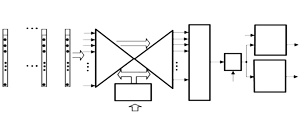Ground reflections effect mitigation for estimation of meteorological signal spectrum based on adaptive lattice filter
DOI:
https://doi.org/10.3103/S0735272722070044Abstract
It is considered the procedures of estimation of meteorological formations parameters by the systems of inter period processing of the signals of pulse Doppler weather radars on a background of clutter generated by reflections of the probing signal from ground and sea (water) surface and objects at the earth surface. They are based on estimations of absolute value and phase of auto-correlation spectral density (ASD) of the mixture of the reflections from meteorological formations and clutter. It is shown that procedures using such estimations and Fourier transformation can be implemented with adaptive lattice filters that increases the efficiency of meteorological formations parameters estimation. It is proposed and researched the alternative estimation procedure which is also based on estimation of ASD absolute value and phase but using “high-resolution” Capon algorithm. On a basis of analysis of errors of estimation of meteorological formations reflections spectral moments using learning samples of finite volume it is shown the advantages and drawbacks of proposed estimation procedures. It is shown that among considered procedures it is advisable to use proposed procedure with estimation of the spectral density of input mixture with “super-resolving” Capon algorithms. Generally it satisfies the requirements to estimation errors for different values of parameters of interferences and meteorological formations, especially in dangerous conditions of strong turbulence of meteorological formations. The alternative method to the researched procedures can be the combination of these procedures.
References
A. V. Ryzhkov, D. S. Zrnic, Radar Polarimetry for Weather Observations. Cham: Springer International Publishing, 2019, doi: https://doi.org/10.1007/978-3-030-05093-1.
A. Collado Rosell, J. P. Pascual, J. Areta, “Adaptive spectral processing algorithm for staggered signals in weather radars,” IET Radar, Sonar Navig., vol. 14, no. 11, pp. 1659–1670, 2020, doi: https://doi.org/10.1049/iet-rsn.2020.0095.
J. Yin, C. M. H. Unal, H. W. J. Russchenberg, “Narrow-band clutter mitigation in spectral polarimetric weather radar,” IEEE Trans. Geosci. Remote Sens., vol. 55, no. 8, pp. 4655–4667, 2017, doi: https://doi.org/10.1109/TGRS.2017.2696263.
A. Collado Rosell, J. Cogo, J. A. Areta, J. P. Pascual, “Doppler processing in weather radar using deep learning,” IET Signal Process., vol. 14, no. 9, pp. 672–682, 2020, doi: https://doi.org/10.1049/iet-spr.2020.0095.
P. Kollias et al., “The ARM radar network: At the leading edge of cloud and precipitation observations,” Bull. Am. Meteorol. Soc., vol. 101, no. 5, pp. E588–E607, 2020, doi: https://doi.org/10.1175/BAMS-D-18-0288.1.
J. C. Hubbert, M. Dixon, S. M. Ellis, “Weather radar ground clutter. Part II: Real-time identification and filtering,” J. Atmos. Ocean. Technol., vol. 26, no. 7, pp. 1181–1197, 2009, doi: https://doi.org/10.1175/2009JTECHA1160.1.
S. M. Torres, D. A. Warde, “Ground clutter mitigation for weather radars using the autocorrelation spectral density,” J. Atmos. Ocean. Technol., vol. 31, no. 10, pp. 2049–2066, 2014, doi: https://doi.org/10.1175/JTECH-D-13-00117.1.
S. M. Torres, D. A. Warde, “Staggered-PRT sequences for Doppler weather radars. Part I: Spectral analysis using the autocorrelation spectral density,” J. Atmos. Ocean. Technol., vol. 34, no. 1, pp. 51–63, 2017, doi: https://doi.org/10.1175/JTECH-D-16-0071.1.
H. Li, D. Moisseev, “Two layers of melting ice particles within a single radar bright band: Interpretation and implications,” Geophys. Res. Lett., vol. 47, no. 13, 2020, doi: https://doi.org/10.1029/2020GL087499.
“Route Radar Complex ‘Sopka-2.’” https://lemz.ru/сопка-2/.
L. Т. Perevezentsev, “Main directions of the development of radar control systems of air traffic,” Proc. Natl. Aviat. Univ., vol. 2, no. 1, 1999, doi: https://doi.org/10.18372/2306-1472.2.9312.
A. D. Siggia, R. E. Passarelli, “Gaussian model adaptive processing (GMAP) for improved ground clutter cancellation and moment calculation,” in Proc. Third European Conf. on Radar in Meteorology and Hydrology, 2004, pp. 67–73.
M.-H. Golbon-Haghighi, G. Zhang, “Detection of ground clutter for dual-polarization weather radar using a novel 3D discriminant function,” J. Atmos. Ocean. Technol., vol. 36, no. 7, pp. 1285–1296, 2019, doi: https://doi.org/10.1175/JTECH-D-18-0147.1.
D. I. Lekhovytskiy, V. P. Riabukha, D. V. Atamanskiy, A. V. Semeniaka, D. S. Rachkov, “Lattice filtration theory. Part I: One-dimensional lattice filters,” Telecommun. Radio Eng., vol. 80, no. 5, pp. 41–79, 2021, doi: https://doi.org/10.1615/TelecomRadEng.2021039186.
D. I. Lekhovytskiy, V. P. Riabukha, D. V. Atamanskiy, A. V. Semeniaka, D. S. Rachkov, “Lattice filtration theory. Part II: Two-variate and multivariate lattice filters,” Telecommun. Radio Eng., vol. 80, no. 6, pp. 55–72, 2021, doi: https://doi.org/10.1615/TelecomRadEng.2021040594.
D. V. Atamanskiy, A. V. Semeniaka, I. V. Krasnoshapka, “Width estimation of non-Gaussian Doppler velocity spectra of meteorological formations,” Radioelectron. Commun. Syst., vol. 64, no. 1, pp. 1–13, 2021, doi: https://doi.org/10.3103/S0735272721010015.
V. Dyakonov, “MATLAB — New opportunities in the technology of spectroscopy and spectrometry,” Kompon. I Tekhnologii, no. 11, 2010, uri: https://kit-e.ru/cad/matlabi-v-spektroskopii-i-spektrometrii/.
R. J. Doviak, D. S. Zrnić, Doppler Radar and Weather Observations. Elsevier, 1984, doi: https://doi.org/10.1016/B978-0-12-221420-2.X5001-7.
D. I. Lekhovytskiy, D. V. Atamanskiy, D. S. Rachkov, A. V. Semeniaka, “Estimation of the energy spectrums of reflections in pulse Doppler weather radars. Part 3. Statistical analysis of the reconstruction techniques of continuous spectrums of the reflections from meteorological objects,” Radioelectron. Commun. Syst., vol. 60, no. 2, pp. 47–79, 2017, doi: https://doi.org/10.3103/S0735272717020017.
D. I. Lekhovytskiy, V. P. Riabukha, D. V. Atamanskiy, A. V. Semeniaka, D. S. Rachkov, “Lattice filtration theory. Part III: ALF adjustment algorithms,” Telecommun. Radio Eng., vol. 80, no. 12, pp. 45–73, 2021, doi: https://doi.org/10.1615/TelecomRadEng.2022042185.
D. I. Lekhovytskiy, V. P. Ryabukha, G. A. Zhuga, D. S. Rachkov, A. V. Semeniaka, “MTD in pulse radars: 5. Adaptive systems for interperiod processing of Gaussian signals against the background of Gaussian clutter,” Appl. Radio Electron., vol. 10, no. 4, p. 508, 2011, uri: http://openarchive.nure.ua/handle/document/4718.
P. A. Bakut, I. A. Bolshakov, B. M. Gerasimov, Issues of Statistical Radio Location Theory, [in Russian]. Moscow: Sov. Radio, 1963.
M. Abramowitz, I. A. Stegun, Eds., Handbook of Mathematical Functions with Formulas, Graphs and Mathematical Tables. Gaithersburg: National Bureau of Standards, 1964.
D. I. Lekhovytskiy, I. G. Kirillov, “The simulation of clutters for pulse radars on the basis of processes of random order autoregression,” Inf. Process. Syst., vol. 3, no. 70, pp. 90–101, 2008, uri: http://www.hups.mil.gov.ua/periodic-app/article/5988.
T. A. Bazlova, “Vol. 1: Scientific-methodology principles,” in Radar Meteorogical Observations, St. Petersburg: Nauka, 2010, p. 312.


